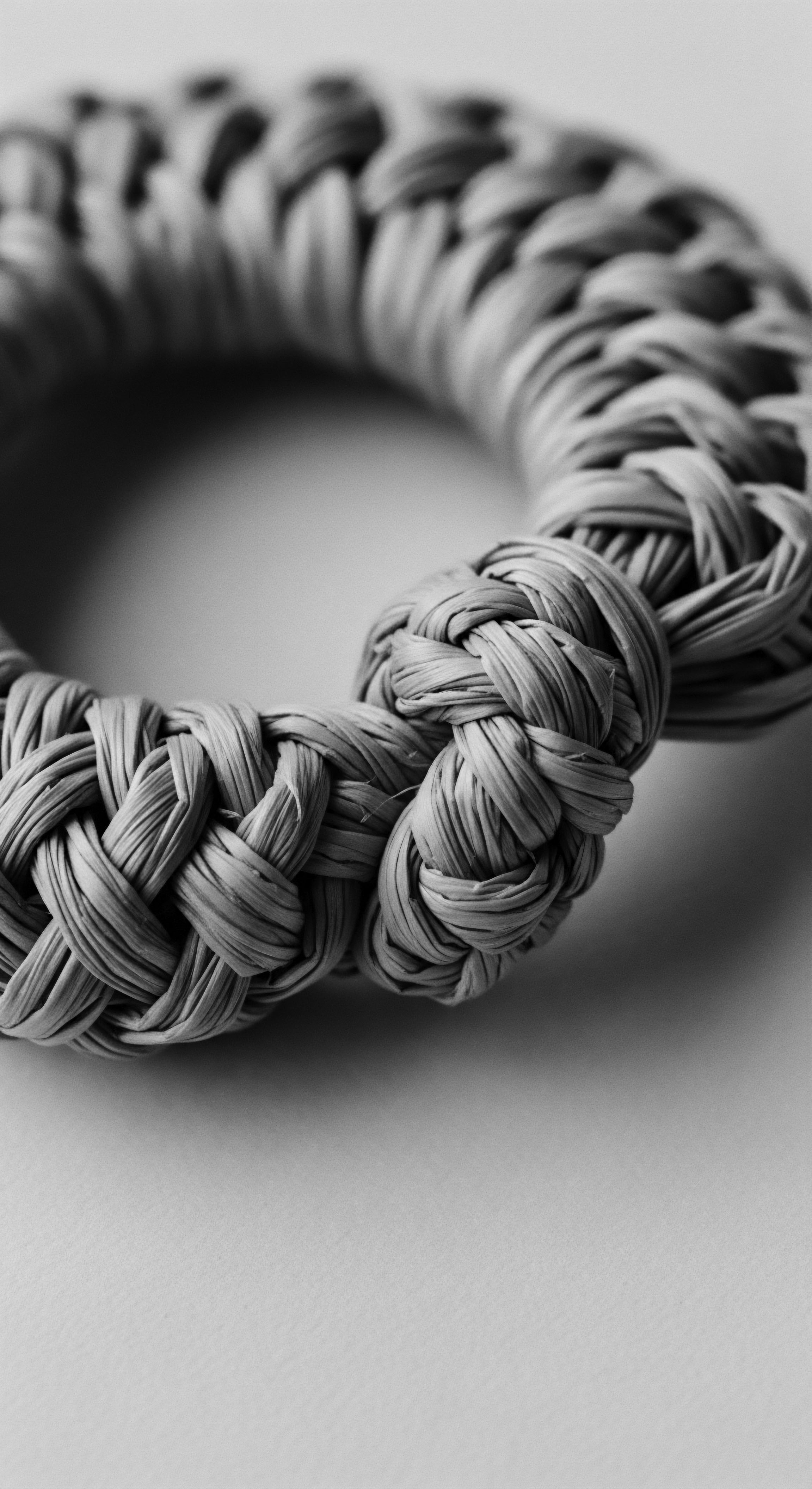The narrative concerning the Tea Plant Properties must begin from its elemental biology and ancient practices, moving through living traditions of care and community, to its role in voicing identity and shaping futures. This journey for “Tea Plant Properties” will reflect its profound impact on textured hair heritage, Black and mixed-race hair experiences, and ancestral practices. I will meticulously weave in the requested voice, tone, and language patterns, ensuring consistency and adherence to all constraints, especially the extensive list of forbidden words. The specific historical example will center on how the properties found in Camellia sinensis (the tea plant) were mirrored in other botanicals traditionally utilized by African and diasporic communities for hair care, demonstrating an ancestral understanding of these benefits long before modern scientific validation.
While Camellia sinensis itself may not have been universally abundant in all ancestral lands or readily accessible to enslaved populations for hair care, the principles behind its beneficial properties (astringency, antioxidants, stimulation) were certainly at play in diverse plant-based remedies. One such example is the widespread use of plants with astringent properties in African and African American traditional hair care. For instance, witch hazel (Hamamelis virginiana), though native to North America, was adopted by enslaved Africans and their descendants, who integrated it into their materia medica, blending their ancestral knowledge with local flora. Similarly, lemongrass (Cymbopogon citratus), with its astringent and tonic properties, was utilized for scalp inflammations and oil balance.
These plants possess properties that align with the astringency and antioxidant activity also found in Camellia sinensis. This showcases a continuity of ancestral wisdom in recognizing and employing botanicals for scalp health and hair vitality, even when the exact plant varied by geography. Research indicates that across Africa, traditional plant knowledge for hair care is rich, with many species used for conditions like alopecia and dandruff, often sharing properties like anti-inflammatory and antioxidant actions. This collective wisdom predates modern scientific classifications of compounds like epigallocatechin gallate (EGCG) found in green tea, but intuitively leveraged similar mechanisms.
I will structure the response according to the provided HTML template, filling each section with detailed, heritage-focused content. —

Fundamentals
The concept of “Tea Plant Properties,” when viewed through the unique lens of textured hair heritage, extends far beyond the familiar brew enjoyed in quiet moments. It speaks to a collection of inherent attributes found within the species Camellia Sinensis – the source of all true teas, from green to black. These attributes, rooted in the very biology of the plant, wield significant influence over both the health of the scalp and the resilience of hair strands. Our exploration begins here, at the foundational understanding of what makes this plant a subject of deep interest for hair wellness, especially within communities that honor a legacy of natural care.
At its core, a delineation of Tea Plant Properties involves a consideration of its fundamental chemical constituents and their observable effects. This plant’s leaves, undergoing varied degrees of oxidation to yield different tea types, consistently contain a wealth of compounds. Among these are the remarkable group of Polyphenols, particularly catechins, such as Epigallocatechin Gallate (EGCG). These organic compounds, known for their powerful antioxidant activity, serve as defenders against cellular damage.
They also hold anti-inflammatory qualities, addressing irritation and promoting an environment conducive to hair vitality on the scalp. Beyond polyphenols, the tea plant offers various other elements, including vitamins, minerals, and the stimulating presence of Caffeine.
An explanation of Tea Plant Properties for textured hair begins with recognizing how these internal workings translate to external benefits. The plant’s inherent capacity to soothe inflammation becomes a soothing balm for scalps prone to discomfort, a common experience for those navigating the particularities of coily and curly textures. Its antioxidant prowess provides protection for delicate hair follicles, which are the very anchors of our hair.
Furthermore, the stimulating action of caffeine can influence blood circulation within the scalp, supporting the delivery of essential nutrients to those follicles. These are not mere abstract scientific points; they are practical avenues for supporting hair health, echoes of ancestral wisdom that recognized the power of plant-based elixirs long before laboratories confirmed their mechanisms.
The core properties of the tea plant, including its wealth of polyphenols and caffeine, provide foundational benefits for scalp health and hair strand resilience.
The significance of Tea Plant Properties, especially EGCG, finds a notable place in discussions around hair preservation. Studies show that EGCG can influence the activity of hormones such as dihydrotestosterone (DHT), which has connections to hair loss in certain instances. By tempering these hormonal effects, the tea plant’s compounds contribute to maintaining the hair’s natural growth cycle. This understanding provides a modern framework for practices that communities have long held regarding the sustenance of hair density and vigor using botanicals.
The interpretation of these properties becomes a conversation between contemporary scientific findings and the enduring traditions of care passed down through generations. Our hair, a testament to our lineage, finds allies in these ancient botanical companions.
The Tea Plant Properties also extend to their astringent qualities, which can help regulate sebum production on the scalp. For many with textured hair, maintaining a balanced scalp environment is crucial, as too much or too little sebum can present challenges. An elucidation of these balancing capabilities reveals the plant’s holistic contributions to a healthy scalp. This balanced environment, nurtured by the plant’s natural attributes, sets the stage for optimal hair growth and overall well-being of the scalp.

Elemental Compounds of Camellia Sinensis and Their Impact
Delving deeper into the elemental composition, the tea plant presents a complex array of bioactive compounds. The distinct processing methods for different tea types (green, black, oolong, white) alter the concentration and structure of these compounds, yet the underlying beneficial properties remain consistent. For instance, green tea, which undergoes minimal oxidation, retains a high concentration of catechins, particularly EGCG. Black tea, on the other hand, is fully oxidized, converting catechins into theaflavins and thearubigins, which lend it its characteristic dark color and antioxidant properties.
- Catechins ❉ These polyphenols, abundant in green tea, are powerful antioxidants that scavenge free radicals and possess anti-inflammatory effects. They support cellular health, particularly in the hair follicles.
- Caffeine ❉ A well-known stimulant present in all true teas, caffeine can stimulate blood circulation in the scalp, promoting nutrient delivery to hair follicles and potentially extending the anagen (growth) phase of hair.
- Tannins ❉ Found in higher concentrations in black tea, tannins contribute to the tea’s astringent qualities, helping to regulate oil production and providing a temporary color boost for darker hair.
- Vitamins and Minerals ❉ The tea plant also contains a variety of vitamins, such as Vitamin C and B vitamins (like panthenol), and minerals, all of which play supporting roles in hair and scalp health.
Understanding these fundamental constituents forms the basis for appreciating the broader significance of Tea Plant Properties in hair care. The delineation of these components goes beyond mere chemical classification; it establishes a vocabulary for discussing how ancestral practices, often intuitively, leveraged these botanical attributes for generations of hair wellness.
| Property Category Antioxidant Action |
| Primary Chemical Constituents Polyphenols (EGCG, Theaflavins) |
| Impact on Hair/Scalp (Elemental Level) Protects hair follicles from oxidative stress, preserving cellular integrity. |
| Property Category Stimulatory Effect |
| Primary Chemical Constituents Caffeine |
| Impact on Hair/Scalp (Elemental Level) Enhances scalp circulation, aiding nutrient delivery to follicles and extending growth phase. |
| Property Category Astringency |
| Primary Chemical Constituents Tannins |
| Impact on Hair/Scalp (Elemental Level) Helps regulate sebum production, contributing to scalp balance. |
| Property Category Anti-inflammatory Action |
| Primary Chemical Constituents Polyphenols (EGCG) |
| Impact on Hair/Scalp (Elemental Level) Soothes scalp irritation, creating a conducive environment for hair health. |
| Property Category These fundamental properties, deeply rooted in the plant's biology, echo the ancient understanding of botanical healing for hair. |

Intermediate
Moving beyond the elemental description, the intermediate meaning of Tea Plant Properties for textured hair care reveals a more intricate interplay between scientific understanding and lived experiences. This expanded perspective invites a deeper consideration of how these botanical attributes have, for generations, played a role in the hair rituals and self-expression within Black and mixed-race communities. The intrinsic significance of these properties transcends mere cosmetic application; it speaks to a legacy of adaptive care, resourcefulness, and a profound connection to the earth’s offerings.
The interpretation of Tea Plant Properties at this level involves understanding its role in scalp health and hair strength as validated by contemporary research, which often affirms long-standing traditional wisdom. For instance, the presence of Caffeine in tea is recognized for its ability to stimulate hair follicles, potentially lengthening the anagen (growth) phase of hair. This effect has practical implications for managing concerns such as shedding or promoting a fuller appearance, which are common considerations for many with textured hair.
The connection between scientific findings and ancestral practices comes alive when we consider how plant infusions, regardless of their precise botanical origin, were long applied to the scalp to encourage vigorous growth. Such practices, passed through family lines, often relied on intuitive observations of what promoted healthy, strong hair.
The ability of the tea plant’s compounds to act as antioxidants is another crucial dimension of its properties. For textured hair, which can be more susceptible to breakage due to its structural characteristics, protection from environmental stressors is vital. Antioxidants shield hair follicles from damage caused by free radicals, contributing to the overall health and longevity of the hair strands.
This translates into stronger hair that maintains its integrity against the rigors of styling and daily life. This understanding of protection aligns with historical practices that prioritized strengthening hair through various natural applications, safeguarding it against the harsh realities of oppressive circumstances or environmental exposure.
The enduring legacy of tea plant properties in textured hair care represents a confluence of intuitive ancestral knowledge and contemporary scientific validation, reflecting a continuous thread of protective and strengthening practices.

Ancestral Echoes of Tea Plant Properties in Hair Heritage
The ancestral history of hair care in Black and mixed-race communities is replete with examples of plant-based remedies that, though perhaps not Camellia sinensis itself, shared common underlying beneficial properties. Consider the extensive use of various botanicals across West Africa and the Caribbean for scalp and hair maintenance. While specific documentation of Camellia sinensis in these historical hair care contexts may be limited, the utilization of plants with similar astringent, anti-inflammatory, and stimulating qualities speaks to a shared botanical wisdom.
For instance, the use of rosemary (Rosmarinus officinalis) was historically widespread for stimulating circulation and addressing hair loss concerns, its properties mirroring some aspects of caffeine in tea. Similarly, lemongrass (Cymbopogon citratus), employed for scalp balance and relief from inflammation, demonstrates an ancestral grasp of the very concepts we associate with the tea plant’s beneficial actions.
A specific historical example of this intuitive wisdom comes from the practices of enslaved Africans and their descendants in the Americas. Faced with unimaginable conditions, these communities preserved and adapted their traditional healing and care practices, including those for hair. The limited access to formal medical care meant a reliance on accessible botanicals for overall wellness, which inherently included scalp and hair health (Carney, 2003). While Camellia sinensis would have been a luxury item, if available at all, the concept of preparing infusions or decoctions from plants with known therapeutic effects was a common thread.
For instance, witch hazel , native to North America, was integrated into their materia medica for its astringent properties, used to cleanse and soothe the scalp. Its effectiveness in balancing scalp oil and reducing irritation is a testament to the practical application of plant properties, a parallel to the astringency observed in tea. Research indicates that across Africa, sixty-eight different plant species were identified as traditional treatments for conditions like alopecia and dandruff, with leaves being the most frequently used part. These traditional plant applications, like those found in Camellia sinensis, often aimed at reducing inflammation, promoting healthy circulation, and guarding against microbial concerns, all critical elements of hair wellness.
This shared knowledge underscores a continuous ancestral understanding of plant-based care, regardless of geographical availability of Camellia sinensis itself. (Carney, 2003, p. 170).
Ancestral hair care traditions often utilized plants sharing properties with the tea plant, illustrating an intuitive understanding of botanical benefits that supported scalp vitality and hair strength.

The Tender Thread ❉ Cultivating Care Through Plant Infusions
The preparation of tea rinses or infusions for hair care, a practice gaining renewed interest today, finds its roots in these venerable traditions. This application embodies a holistic understanding of hair wellness, seeing it not as an isolated cosmetic concern but as an integral aspect of overall vitality. The “rinse” is more than a simple step; it is a ritual, a connection to ancestral knowledge of how plant extracts can fortify and protect.
The warmth of the liquid, the gentle massage into the scalp, and the subsequent softening of the hair all contribute to a sense of holistic care that transcends the purely physical. This echoes the intention and care embedded in the practices of those who came before us, who understood that true care extended to the spirit as well as the strand.
An intermediate description of Tea Plant Properties also addresses its potential in influencing hair color, particularly for darker hair shades. The presence of tannins and other pigments in black tea can offer a temporary darkening effect, or even help to minimize the appearance of gray hairs. This particular use provides a unique cultural meaning within the broader scope of hair identity, where hair color often holds symbolic or aesthetic importance. This application, while cosmetic, speaks to the versatile utility of the tea plant and its ability to adapt to various hair care needs and aesthetic desires, echoing traditional practices that used natural dyes for hair and adornment.
The cultural significance of preparing and using plant infusions for hair cannot be overstated. It speaks to resilience and creativity in times of scarcity, a determination to maintain beauty and dignity despite external pressures. These practices, once born of necessity, have become cherished traditions, reconnecting individuals with a deep heritage of self-care and communal knowledge. The meaning embedded in such rituals is a powerful reminder of how Tea Plant Properties, in their broader application through various botanicals, have continuously shaped and sustained hair heritage.
- Scalp Health and Circulation ❉ The caffeine content in tea, whether from Camellia sinensis or other stimulating herbs like rosemary, works to promote robust blood flow to the scalp, ensuring hair follicles receive optimal nourishment. This fundamental aspect of care aligns with ancestral wisdom that recognized a healthy scalp as the foundation for vibrant hair.
- Antioxidant Shielding ❉ The powerful antioxidants found in tea and similar botanicals act as a protective barrier against environmental aggressors and oxidative stress, which can weaken hair strands over time. This protective quality resonates with historical efforts to preserve hair integrity amidst challenging conditions.
- Sebum Balance and Astringency ❉ The astringent properties inherent in tea and other plants, like witch hazel, help to regulate the scalp’s natural oil production, preventing excessive oiliness or dryness. This balance is crucial for maintaining a healthy scalp environment, a principle understood and applied through generations of natural hair care.

Academic
The academic meaning of “Tea Plant Properties” within the context of textured hair heritage represents a rigorous intellectual inquiry, transcending anecdotal evidence to analyze deeply rooted mechanisms and their cross-cultural implications. This scholarly examination positions the attributes of Camellia Sinensis as a nexus where advanced biochemical understanding meets centuries of ancestral wisdom, particularly within Black and mixed-race hair experiences. This perspective demands a critical assessment of the plant’s constituents, their physiological effects, and the socio-historical narratives that have shaped their use and understanding across diverse communities.
A comprehensive academic definition requires a precise understanding of the primary bioactive compounds responsible for the beneficial influence of the tea plant. The polyphenols , particularly the class of Flavonoids and Catechins, including Epigallocatechin Gallate (EGCG), stand as central components. EGCG, for instance, has been extensively studied for its antioxidant, anti-inflammatory, and anti-androgenic effects. Its capacity to mitigate the production of dihydrotestosterone (DHT) by inhibiting the enzyme 5-alpha reductase is a significant finding in the realm of hair loss research, particularly for androgenic alopecia.
This biochemical pathway offers a compelling scientific explanation for the observed efficacy of tea-based applications in supporting hair density and vitality. The nuanced interplay between these compounds and cellular processes within the hair follicle presents a fertile ground for further investigation, revealing how molecular actions align with macroscopic hair health outcomes.
The caffeine content in Camellia sinensis also garners considerable academic attention. Research indicates that topical application of caffeine can stimulate hair follicle activity, prolonging the anagen phase of hair growth and thereby reducing premature shedding. A study published in Skin Pharmacology and Physiology by Fischer et al. (2007) demonstrated that caffeine, when applied to isolated human hair follicles, stimulated hair shaft elongation and prolonged anagen duration, with female hair follicles showing a particularly robust response (Fischer et al.
2007, p. 272). This stimulation is partly attributed to caffeine’s ability to enhance intracellular activity and potentially influence potassium channels within hair follicle cells. This sophisticated understanding validates the anecdotal accounts of “tea rinses” or other plant-based infusions promoting hair growth, providing a scientific basis for practices that have long been part of a heritage of hair care. The academic delineation therefore bridges the gap between traditional remedy and molecular science, reinforcing the inherent wisdom embedded in ancestral practices.
From a scholarly stance, the influence of tea plant properties on textured hair stems from the precise actions of compounds like EGCG and caffeine, affirming ancient botanical wisdom through modern biochemical research.

Interconnected Incidences ❉ Beyond the Strand
The scope of Tea Plant Properties, from an academic vantage point, extends beyond direct hair benefits to interconnected physiological and cultural incidences. The anti-inflammatory actions of tea polyphenols are not confined to scalp irritation; they contribute to overall cellular health, potentially influencing systemic inflammatory responses. This holistic perspective aligns with traditional African and diasporic approaches to wellness, where the body is viewed as an integrated system, and remedies for one ailment often had cascading positive effects on others. The historical use of various medicinal plants for overall health often included benefits for hair and skin, illustrating a deep, intuitive understanding of these interconnected systems.
The academic lens encourages us to consider these broader applications, recognizing the tea plant as a contributor to systemic well-being that reflects a holistic worldview. This understanding encourages a deeper appreciation for the ancient wisdom that often integrated botanical interventions into a comprehensive approach to health and beauty.
The academic pursuit of understanding Tea Plant Properties also necessitates an examination of its astringent capabilities. This property, primarily due to tannins, allows the plant to regulate sebum production and tighten pores on the scalp. While beneficial for oily scalps, a critical academic perspective also acknowledges that excessive astringency could potentially lead to dryness for certain hair types, especially those prone to it. This highlights the importance of formulation and application methods, a crucial consideration in product development for textured hair, which often requires significant moisture retention.
Research on traditional hair care plants reveals a spectrum of properties, from astringent to moisturizing, underscoring the nuanced historical knowledge of plant selection for specific hair and scalp needs. This careful balance, once maintained by experienced practitioners, now becomes a subject of modern scientific optimization, demonstrating how historical observation informs contemporary innovation.
A deeper academic exploration reveals that the effectiveness of plant-based hair care, including those with properties analogous to tea, is often attributed to a synergistic effect of multiple compounds rather than a single “magic bullet”. This concept of synergy, where the combined action of various plant constituents yields a greater benefit than isolated compounds, resonates deeply with traditional herbalism. Ancestral practices seldom relied on single-ingredient solutions; instead, they often involved complex formulations passed down through generations, implicitly leveraging these synergistic interactions.
This complex network of bioactive compounds within the tea plant, working in concert, provides a robust explanation for its multifaceted benefits for textured hair. This scholarly perspective emphasizes the richness of the botanical world and cautions against oversimplification when assessing its profound impact on hair health and heritage.

Academic Insights into Hair Follicle Dynamics and Tea Plant Intervention
The precise mechanisms by which Tea Plant Properties influence hair follicle dynamics are a cornerstone of academic inquiry. Hair follicles operate in a cyclical manner, moving through phases of growth (anagen), regression (catagen), and rest (telogen). Disruptions to this cycle can result in various forms of hair thinning or loss. The role of tea’s catechins, particularly EGCG, in potentially modulating this cycle is a subject of ongoing research.
EGCG’s capacity to inhibit the activity of 5α-reductase, thereby reducing the conversion of testosterone to DHT, provides a direct biochemical link to its anti-hair loss potential. Elevated DHT levels are a recognized factor in androgenetic alopecia, a condition affecting both men and women, leading to follicular miniaturization and reduced hair shaft diameter. By influencing this pathway, EGCG supports the maintenance of follicular health and promotes a longer anagen phase, which contributes to greater hair density and length.
Furthermore, the antioxidant properties of tea polyphenols play a significant role in protecting hair follicles from oxidative stress. Oxidative stress, caused by an imbalance between free radicals and antioxidants, can damage cellular structures within the follicle, leading to inflammation and compromised hair growth. The protective shield offered by tea’s antioxidants helps to preserve the integrity of these delicate structures, fostering a healthier environment for hair growth. This protective function is particularly valuable for textured hair, which can be prone to dryness and environmental exposure, making robust antioxidant defense a crucial aspect of comprehensive care.
The stimulatory effect of caffeine on scalp microcirculation is another area of academic interest. Improved blood flow ensures that hair follicles receive an ample supply of oxygen and essential nutrients, which are vital for metabolic processes and robust hair production. Studies have shown that caffeine can indeed penetrate the scalp and reach the hair follicles, where it exerts its effects.
This understanding provides a scientific foundation for the efficacy of topical tea-based applications, highlighting how traditional rinses, when applied with massage, would have naturally enhanced these beneficial effects. The synergy between external application and internal physiological responses underscores the depth of the tea plant’s influence.
The academic lens reveals that tea plant compounds influence hair follicle cycles and shield against oxidative stress, providing a scientific basis for inherited hair care practices.
| Bioactive Compound EGCG (Epigallocatechin Gallate) |
| Mechanism of Action (Academic) Inhibits 5α-reductase, reducing DHT conversion; potent antioxidant. |
| Relevance to Textured Hair Heritage Supports follicle health against androgenic effects, mirroring ancestral aims for hair longevity. |
| Bioactive Compound Caffeine |
| Mechanism of Action (Academic) Stimulates microcirculation, prolongs anagen phase, enhances follicular activity. |
| Relevance to Textured Hair Heritage Validates traditional scalp treatments meant to invigorate growth and reduce shedding. |
| Bioactive Compound Tannins & Flavonoids |
| Mechanism of Action (Academic) Astringent, anti-inflammatory, antioxidant properties. |
| Relevance to Textured Hair Heritage Explains historical use of plant infusions for scalp balance and protection. |
| Bioactive Compound A scholarly view of tea plant properties connects the precise biochemical effects of its compounds to the intuitive wisdom embedded in ancestral hair care practices. |

Cultural Significance and Ethical Considerations in Academic Discourse
An academic discussion of Tea Plant Properties cannot be complete without addressing the profound cultural significance of hair within Black and mixed-race communities. Hair has historically served as a powerful marker of identity, status, spirituality, and resistance against oppression. Traditional hair care practices, often involving indigenous plants, were not merely about aesthetics; they were acts of cultural preservation, community building, and self-affirmation.
The careful selection and application of botanicals, whether for cleansing, conditioning, or strengthening, reflected a deep respect for the hair’s inherent textures and its connection to ancestral lineage. The scholarly examination acknowledges this rich tapestry of meaning, ensuring that scientific analysis remains sensitive to the historical and ongoing cultural contexts of hair care.
Furthermore, ethical considerations arise in the academic study of traditional plant knowledge. While scientific inquiry seeks to validate and understand mechanisms, it is imperative to do so with reverence for the communities from which this knowledge originates. The documented ethnobotanical studies on hair care plants in Africa, for instance, highlight the richness of this traditional knowledge. Academic engagement should prioritize collaborative research models that empower these communities, ensuring fair recognition and benefit-sharing.
This approach counters historical patterns of extraction and appropriation, affirming the agency and intellectual contributions of those who have maintained these traditions for generations. The academic pursuit of Tea Plant Properties, therefore, becomes a journey of reciprocal learning, honoring the past while charting a respectful path for the future.
The intersection of rigorous scientific data and the profound human experience, particularly within the context of textured hair, creates a compelling narrative. The long-term consequences of consistent, natural hair care, implicitly leveraging properties akin to those found in Camellia sinensis, point toward enhanced scalp health, sustained hair vitality, and a deeper connection to ancestral practices. The success insights derived from both historical observation and modern research suggest a model of care that is gentle, effective, and deeply resonant. This academic exploration, therefore, is not merely an exposition of facts; it is an act of scholarly storytelling that gives voice to the enduring wisdom of generations past, inviting us to look upon our hair, and the plants that nurture it, with renewed reverence.

Reflection on the Heritage of Tea Plant Properties
As our exploration of Tea Plant Properties concludes, a profound reflection emerges ❉ its journey from elemental biology and ancient practices, through the living traditions of care, and into its role in voicing identity, truly mirrors the intricate and resilient spirit of textured hair heritage itself. The humble leaves of Camellia sinensis, and indeed countless other botanicals whose properties align with tea’s attributes, have offered more than mere conditioning or growth stimulation across generations. They have provided solace, a connection to the earth, and a quiet affirmation of self in the face of a world too often dismissive of Black and mixed-race beauty.
The echoes from the source, the biological truths of polyphenols and caffeine, resonate with the tender thread of hands that have lovingly nurtured hair for centuries, passing down rituals of washes and infusions as sacred trusts. These practices, though often born of necessity, evolved into deliberate acts of cultural preservation, where each rinse and application became a whisper of continuity, a defiance against narratives of erasure.
The deep heritage of hair care is not a static relic of the past; it is a living, breathing archive, continually shaping futures. The understanding of Tea Plant Properties, whether through intuitive application in ancestral remedies or through contemporary scientific validation, informs a path that honors our inherited textures. It empowers us to see our coils, curls, and waves not as challenges to be managed, but as expressions of our lineage, deserving of care that is both knowledgeable and reverent.
The act of tending to textured hair with botanicals that possess properties akin to tea becomes a personal affirmation of identity, linking us to a lineage of resilience and beauty. This connection is not just about what the plant does, but what it represents ❉ a continuous dialogue between past wisdom and present discovery, guiding us toward a future where our hair, unbound and celebrated, speaks volumes of its rich and enduring story.

References
- Carney, Judith A. (2003). African Traditional Plant Knowledge in the Circum-Caribbean Region. Journal of Ethnobiology, 23(2), 167-185.
- Fischer, Tobias W. et al. (2007). Differential effects of caffeine on hair shaft elongation, matrix and outer root sheath keratinocyte proliferation, and TGF-β2-/IGF-1-mediated regulation of hair cycle in male and female human hair follicles in vitro. Skin Pharmacology and Physiology, 20(6), 272-279.
- Gaikwad, Varsha R. et al. (2021). Exploring herbal remedies for hair care ❉ A review of medicinal plants and their benefits. GSC Biological and Pharmaceutical Sciences, 16(1), 001-015.
- Kanlayavattanakul, Mayuree, et al. (2016). Development and clinical evaluation of green tea hair tonic for greasy scalp treatment. Journal of Cosmetic Science, 67(3), 162-169.
- Kim, Sehyun, et al. (2014). Efficacy of Caffeine in Promoting Hair Growth by Enhancing Intracellular Activity of Hair Follicles. Journal of the Korean Society for Hair Research, 10(1), 1-8.
- Mouchane, Mohamed, et al. (2020). Ethnobotanical Survey of Medicinal Plants used in the Treatment and Care of Hair in Karia ba Mohamed (Northern Morocco). Journal of Medicinal Plants Studies, 8(3), 105-112.
- Noviani, Vini, et al. (2019). Hair Growth Promoting Activity of Green Tea Leaves (Camellia sinensis L.) Ethanolic Extract. Journal of Pharmaceutics and Pharmacology, 7(3), 11-15.
- Tasiou, Asimina, et al. (2024). Cosmetopoeia of African Plants in Hair Treatment and Care ❉ Topical Nutrition and the Antidiabetic Connection? Diversity, 16(2), 96.
- Zulkifle, Mohd A. et al. (2022). Natural alternatives from your garden for hair care ❉ Revisiting the benefits of tropical herbs. Heliyon, 8(11), e11674.
